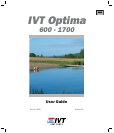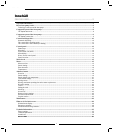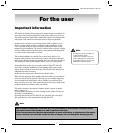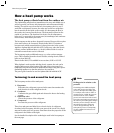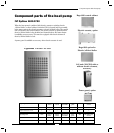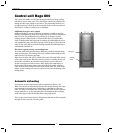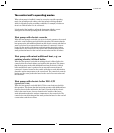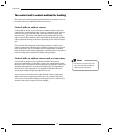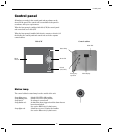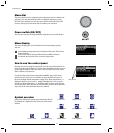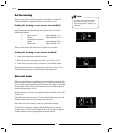
6
How a heat pump works
The heat pump collects heat from the outdoor air
The Optima heat pump has been manufactured for easy and reliable use as
well as to provide your house with inexpensive and environment friendly
heating. The easiest way to describe how a heat pump works is to say it
works like a refrigerator, however, the other way round. In a refrigerator
heat is moved from the inside to the outside. In a heat pump the heat, in
the outdoor air, is moved into the house. The heat pump is placed on the
outside of your house. The heat that is in the air, even at temperatures
below zero, is converted by the compressor, heat exchanger and condenser
into hot water, which heats your house.
The heat pump can also produce domestic hot water. However, this requires
a hot water heater to be connected. Electric boiler 290 A/W contains a
hot water tank, which means that there is always hot water in the system
(applies to Optima 600-1100 with 290 A/W). In this case, when the electric
cassette or mixed additional heat, e.g. electric/oil-fi red boiler is used, an
external hot water heater can be connected.
The heat pump requires additional energy, e.g. at low outdoor tempera-
tures. This is obtained from the electric cassette, existing electric/oil-fi red
boiler or from 290 A/W.
Electric boiler 290 A/W is available in two versions, 9 kW or 13.5 kW.
When Optima is used together with the electric cassette, the unit can be
supplied with a power guard (option). The task of the power guard is to
temporarily disconnect the electric additional heat when using other power
demanding appliances so that the main fuse does not blow.
The power guard can also be used for Optima 600-1100 with 290 A/W.
Boiling point in relation to the
pressure
The boiling point of different liquids
varies with pressure, the higher the
pressure, the higher the boiling point.
For example, water boils at +100ºC at
normal pressure. Double the pressure
and water boils at +120ºC. Half the
pressure and water then boils at +80ºC.
The refrigerant in the heat pump acts in
the same way, the boiling point changes
when the pressure changes. However,
the boiling point of the refrigerant
is as low as approximately -40ºC at
atmospheric pressure. Consequently,
it is also suitable for low heat source
temperatures.
Note
Technology in and around the heat pump
The heat pump consists of four main parts:
1. Evaporator
Evaporates the refrigerant to gas and at the same time transfers the
heat from the air to the refrigerant circuit.
2. Condenser
Condenses the gas to fluid again and releases the heat to the heating
system.
3. Expansion valve
Lowers the pressure of the refrigerant.
4. Compressor
Increases the pressure of the refrigerant.
These four main parts are linked in two closed circuits. A refrigerant
circulates in the heat pump, which in some parts of the circuit is in a liquid
state and in other parts in a gas state. Read more about the properties of the
refrigerant in the sidebar to the right.
See the detailed description of the technologies used in the heat pump on
the next page.
How a heat pump works



